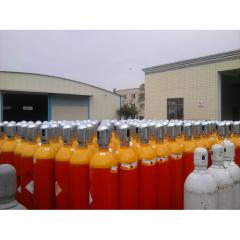PRODUCT
News center
-
2015-03-24
The safety of the mixed gas production and management -
2015-03-24
The preparation of standard gas and application -
2015-03-24
Talk about the standard gas development of our country
Current Position:Product > High purity gases
Carbon Monoxide Product Description
Under normal temperature and pressure of carbon monoxide is a colorless, odorless, tasteless, non-irritating asphyxiating gas, carbon monoxide gas density under the standard conditions of 1.25g / L, close to the air density (standard conditions 1.293g / L). Gray cylinders commonly used in industrial packaging and sprayed on the cylinder with the words "carbon monoxide" red, and affixed with flammable compressed toxic identity map, valves, etc. using the QF-30C anti-threaded outlet bottle valve. Combustible carbon monoxide in the air, emit a blue flame combustion, explosion limits in air is 12.5% to 74%.
Carbon monoxide poisoning is their parents together with hemoglobin than oxygen affinity of hemoglobin up to 300 times, so vulnerable to carbon monoxide and hemoglobin hemoglobin oxygen-carrying capacity and role of the loss, resulting in brain and other tissues asphyxia, carbon monoxide poisoning is often difficult self-help. Gas poisoning usually say is actually carbon monoxide poisoning.
Industrial production of carbon monoxide, methanol cracking carbon monoxide, carbon monoxide and other water-gas system, with yellow phosphorus tail, closed calcium carbide furnace gas, steelmaking converter gas, blast furnace gas, carbon monoxide exhaust and other rich industrial exhaust gas purification recycling carbon monoxide more is an environmentally friendly mode of production efficiency.
Carbon monoxide at high temperature and pressure, and iron-chromium-nickel and other metal carbonyl metal reacts with chlorine to form phosgene, and metal carbonyls to form metal carbonyl compounds. Carbon monoxide has a reducing action, at room temperature for manganese and copper oxide are mixed, the carbon monoxide oxidized into CO2, there is a gas mask is to use this principle. Carbon monoxide main fuel, a reducing agent, synthetic organic materials, preparing the metal-carbonyl, phosgene, sulfur carbon oxides, aromatic aldehydes, formic acid, mellitic phenol, aluminum chloride, methanol, is used for the hydroformylation role as, tilapia for preservation, preparation combined hydrocarbon (synthesis gas), co-alcohol (a mixture of carboxymethylcellulose, alcohols, aldehydes, ketones and hydrocarbons), zinc white paint, aluminum film, standard gas, calibration gas, on-line instrumentation standard gas.
Application of carbon monoxide
Bottled carbon monoxide used in fresh tilapia, fish is an excellent gas hair color agent.
Carbon monoxide-rich plant tail gas for the synthesis of methanol, to create profits to support environmental protection spirit.
Carbon monoxide standards for the preparation of carbon monoxide gas to calibrate carbon monoxide alarm.
High purity carbon monoxide used in the synthesis of pharmaceuticals, pesticides, fragrances and Hugh important intermediate and other fine chemicals.
Carbon monoxide gas is used as a reducing metal restore to purify certain metals.
Gas as a fuel cell.
Carbon monoxide is used in medical research, can help organ transplant.
Carbon monoxide Notes
High-pressure filling bottled carbon monoxide gas, should be used by decompression buck before use, you must give the gas pipeline with nitrogen pressure test before use with soap and water leak testing, helium leak testing packing, make sure the gas pipeline does not leak. The working environment should be ventilated, and install carbon monoxide alarms. Carbon monoxide alarms should be regularly calibrated standard gas.
Moving and handling carbon monoxide cylinders, cylinder should bring a bottle cap, using a special trolley moving cylinders and cylinders with chains fixed to ensure that no damage to the cylinder valve assembly. When long-distance transport of gas and other professionals hired spectrum source gas distributor transport of dangerous goods transport vehicles.
Life of the carbon monoxide gas cylinders are used in packaging, where the expired gas cylinders must be taken to have the dealer commission corresponding safety inspection department before they can continue to use.
Bottle when using the exhaust gas, and pressure in the bottle should be kept 0.5MPa, more than the minimum of not less than 0.25MPa pressure cylinder valve should be closed to ensure the gas quality and safe to use.
Bottled carbon monoxide in the transport and storage, the use of classification should be stacked, non-combustible gas and combustion gas stacked together, are not allowed near open flames and heat sources, do not get near the fire should be, not contaminated with oil wax, not prolonged sun exposure, not weight throw, Do not hit, who were prohibited in the carbon monoxide gas cylinders arc or arc, rough handling is strictly prohibited.
The physical and chemical properties of carbon monoxide
MW: 28.0104
Melting point (triple point 15.3kPa): - 205.1 ℃
Boiling point (101.325kPa): - 191.5 ℃
Liquid density (-191.5 ℃, 101.325kPa): 789kg / m3
Gas density (0 ℃, 101.325kPa): 1.2504kg / m3
Relative density (gas, air = 1,101.325kPa): 0.967
Hematocrit: (21.1 ℃, 101.325kPa): 0.8615m3 / kg
Gas-liquid volume ratio: (15 ℃, 100kPa): 674L / L
Critical temperature: -140.2 ℃
Critical pressure: 3499kPa
Critical Density: 301kg / m3
Compression factor:
|
Temperature
(℃) |
Compression factor
|
|||
|
100kPa
|
1000kPa
|
5000kPa
|
10000kPa
|
|
|
15
50 |
0.9996
0.9998 |
0.9959
0.9988 |
0.9848
0.9981 |
0.9845
1.0070 |
The heat of fusion (-205.01 ℃, 15.36kPa): 29.9kJ / kg
Heat of vaporization (-191.53 ℃, 101.325kPa): 215.2kJ / kg
Specific heat capacity (gas, 25 ℃, 101.325kPa): Cp = 1043J / (kg · K)
Cv = 742J / (kg · K)
Specific heat ratio (gas, 25 ℃, 101.325kPa): Cp / Cv = 1.404
Vapor Pressure (-203.43 ℃): 20.00kPa
(-180 ℃): 305kPa
(140 ℃): 3500kPa
Viscosity (101.325kPa, 0 ℃): 0.01662mPa · S
Surface tension (-193 ℃): 9.8mN / m
Thermal conductivity (101.325kPa, 0 ℃): 0.02303W / (m · K)
Refractive index (gas, 0 ℃, 101.325kPa): 1.0003342
Air combustible range (20 ℃, 101.325kPa): 12.5% ~ 74%
The lowest air ignition (101.325kPa): 630 ℃
Most easily ignited concentration: 30%
Produce the maximum explosion pressure of concentration: 35.2%
The maximum explosion pressure: 6.3kg / cm3
Toxicity Level: 2
Flammability Rating: 4
Explosive level: 0
Fire risk: great

